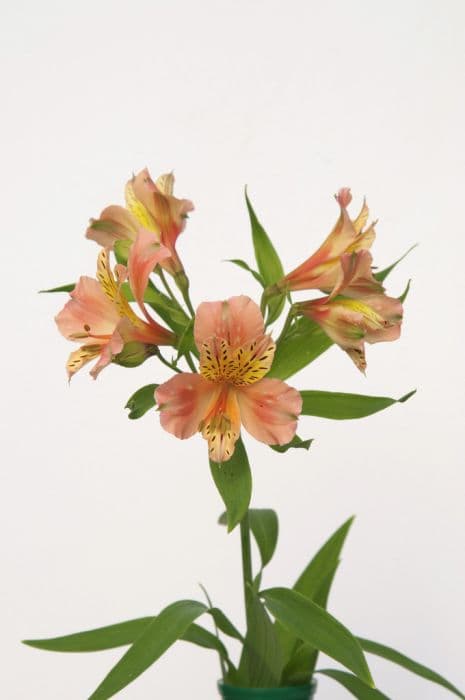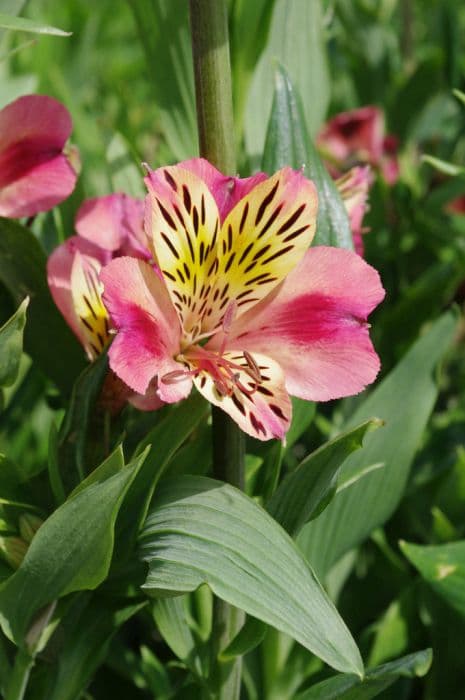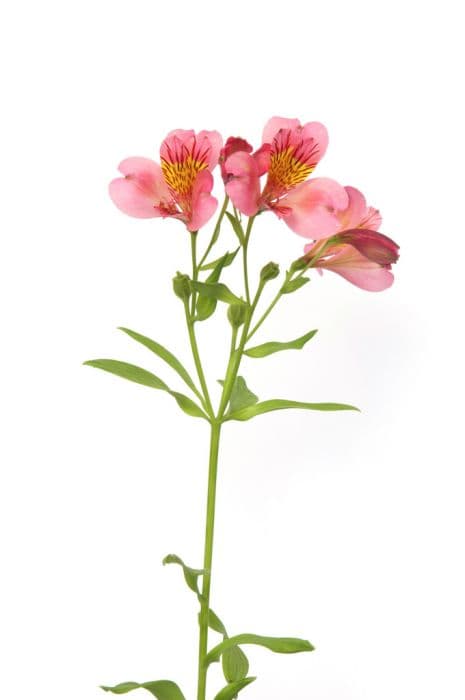Peruvian Lily Alstroemeria Princess Ariane = 'Zapriari' (PBR) (Princess Series)
![Peruvian lily [Princess Ariane]](/_next/image?url=https%3A%2F%2Fplants-admin.emdemapps.com%2Fimages%2Fplants%2F%2Fimages%2F604b5e20e8950.png&w=3840&q=75)
ABOUT
The Alstroemeria Princess Ariane, part of the Princess Series, is a vibrant and eye-catching plant known for its distinctive and attractive blooms. This particular variety features flowers with a delightful blend of colors. The petals exhibit a creamy-white base color, overlaid with brush strokes of pink and speckled with rich, dark spots. The contrast between the soft background and the striking freckles creates a dramatic visual effect. Each blossom is characterized by a set of six slightly curved petals, arranged in a symmetrical fashion around a central core. The flowers form clusters that enhance the visual impact of the plant. In addition to the striking blooms, the foliage of the Alstroemeria Princess Ariane is equally noteworthy. The leaves are glossy and lance-shaped, displaying a deep green hue that serves as a perfect backdrop to the lively flowers. The leaves may also exhibit a unique twist, where the bottom side faces upwards, which adds to the visual intrigue of the plant. Overall, the striking flowers and the rich green foliage come together to create a lush and exotic appearance, making the Alstroemeria Princess Ariane a favorite for adding a touch of elegance and color to any space where it is displayed.
About this plant
 Names
NamesFamily
Alstroemeriaceae.
Synonyms
Peruvian Lily, Lily of the Incas, Princess Lily, Alstroemeria Princess Ariane.
Common names
Alstroemeria Princess Ariane = 'Zapriari' (PBR) (Princess Series).
 Toxicity
ToxicityTo humans
Alstroemeria, commonly known as the Peruvian Lily or Lily of the Incas, can cause mild toxicity if ingested by humans. The plant contains tulipalin, a compound that can cause allergic reactions in some people. If ingested, the most common symptoms include nausea, vomiting, and diarrhea. In rare cases, skin contact with the sap can result in dermatitis or skin irritation. It’s important to handle these flowers with care to avoid potential allergic reactions.
To pets
The Peruvian Lily is also mildly toxic to pets, including dogs and cats. If a pet ingests part of the plant, it can experience vomiting, diarrhea, and abdominal pain. Similar to its effect on humans, the sap of the Peruvian Lily can cause skin irritation in pets. To prevent any adverse effects, it’s wise to keep this plant out of reach of pets.
 Characteristics
CharacteristicsLife cycle
Perennials
Foliage type
Deciduous
Color of leaves
Green
Flower color
Mixed
Height
1 foot 2 inches (35-40 cm)
Spread
1 foot (30 cm)
Plant type
Herb
Hardiness zones
7
Native area
South America
Benefits
 General Benefits
General Benefits- Long-lasting blooms: The Alstroemeria, commonly known as the Peruvian Lily, produces flowers that can last for several weeks, both on the plant and as cut flowers in a vase.
- Vibrant colors: The Peruvian Lily offers a wide range of vivid colors, enhancing the visual appeal of any garden or floral arrangement.
- Attracts pollinators: This plant attracts bees and butterflies, which are essential for the pollination of plants, boosting biodiversity in the garden.
- Drought resistance: Once established, the Peruvian Lily can withstand periods of dry weather, making it suitable for gardens with limited water resources.
- Easy propagation: The plant can be easily propagated by dividing the root clumps, allowing gardeners to multiply their stock or share with others.
- Versatility in landscaping: The Peruvian Lily is suitable for use in borders, containers, and as a ground cover, making it a versatile choice for various landscaping needs.
- Minimum pest problems: The plant is relatively resistant to pests, reducing the need for chemical treatments.
- Seasonal interest: With its bloom time spanning from late spring to early fall, the Peruvian Lily provides a long season of aesthetic interest in the garden.
 Medical Properties
Medical PropertiesThis plant is not used for medical purposes.
 Air-purifying Qualities
Air-purifying QualitiesThis plant is not specifically known for air purifying qualities.
 Other Uses
Other Uses- Natural Dye Source: The brightly colored petals of the Alstroemeria can be used to create natural dyes for textiles, offering an eco-friendly alternative to synthetic dyes.
- Photography Subjects: Due to their striking appearance, Alstroemeria flowers are often used by photographers as main subjects or backgrounds in floral photography.
- Edible Flower Garnishes: While not commonly known, the petals of Alstroemeria can be used as decorative, edible garnishes for salads and desserts to add a splash of color.
- Crafting and Scrapbooking: Pressed Alstroemeria flowers are used in crafting activities like scrapbooking or making handmade bookmarks and greeting cards.
- Fragrance Extraction: Although not a primary source, the subtle scent of Alstroemeria flowers can be extracted and used in homemade perfumes and scented oils.
- Color Inspiration: Alstroemeria's diverse color palette can inspire artists and designers when choosing color schemes for their works.
- Teaching Botany: Alstroemeria flowers can be used for educational purposes, such as teaching botany and horticulture, given their interesting reproductive mechanisms.
- Artistic Inspiration: Artists may use the intricate patterns and colors of the Alstroemeria as inspiration for paintings, textiles, and other art forms.
- Culinary Inspiration: The distinct look of Alstroemeria flowers can inspire cake decorators and pastry chefs in designing creative and colorful confectionery.
- Watercolor Painting: The delicate gradients and vivid colors of Alstroemeria petals make them great subjects for watercolor artists looking to capture floral essences.
Interesting Facts
 Feng Shui
Feng ShuiThe Alstroemeria is not used in Feng Shui practice.
 Zodiac Sign Compitability
Zodiac Sign CompitabilityThe Alstroemeria is not used in astrology practice.
 Plant Symbolism
Plant Symbolism- Friendship: Alstroemeria, commonly known as the Peruvian Lily or Lily of the Incas, often symbolizes strong and enduring friendship because of its twisted leaves which represent the ups and downs of friendships.
- Devotion and Loyalty: The plant is known to bloom for a long time, representing a binding connection between people that is devoted and loyal.
- Wealth, Prosperity, and Fortune: The Peruvian Lily is sometimes given as a gift to wish someone prosperity and fortune in their life, reflecting the belief that the recipient will have a rich and rewarding experience.
- Resilience and Survival: Because Alstroemeria can adapt and survive in different climates, it symbolizes the ability of an individual to persist through challenging conditions.
- Achievement of Aspirations: The vibrant blooms of Alstroemeria are thought to signify the striving and achievement of goals or aspirations.
 Water
WaterPeruvian lilies, including Alstroemeria Princess Ariane, should be watered deeply to encourage root growth, amounting to about 1 to 2 inches per week, depending on weather conditions. In hotter, drier periods, you may need to water every other day, whereas in cooler, damp weather, watering once a week may suffice. It's important to allow the topsoil to become slightly dry between waterings to prevent overwatering and root rot. Using a soaker hose or drip irrigation can provide a gentle and deep watering that is ideal for these plants. Adjust your watering schedule based on rainfall and avoid overhead watering to keep the foliage dry and prevent fungal diseases.
 Light
LightPeruvian lilies thrive in full sun to partial shade conditions. The best spot for them is where they can receive at least 6 hours of sunlight daily, with some protection from the intense midday sun, especially in hotter climates. Morning sunlight is preferable as it is less harsh and helps to dry dew from the leaves, reducing the risk of disease.
 Temperature
TemperaturePeruvian lilies do best in temperatures ranging from 65 to 75 degrees Fahrenheit and can survive minimum temperatures of around 25 to 28 degrees Fahrenheit once established. It's crucial to protect the plant from frosts which can damage the foliage and flowers. Ideally, these plants should be grown in areas where the temperature does not drop below freezing to ensure they thrive.
 Pruning
PruningPruning Peruvian lilies is necessary to remove spent flowers and encourage further blooming throughout the season. Cut back the stems that have finished flowering to the base to promote new growth. At the end of the blooming season, typically late fall, cut back the foliage to tidy the plant and prepare it for winter dormancy. Pruning is also an opportunity to divide overcrowded clumps, which can be done every couple of years.
 Cleaning
CleaningAs needed
 Soil
SoilThe best soil mix for Princess Lilies (Alstroemeria) is well-draining, fertile, and loamy, with added organic matter like compost. The pH should be mildly acidic to neutral, around 6.5 to 7.0.
 Repotting
RepottingPrincess Lilies should be repotted every 2 to 3 years to refresh the soil and allow for growth. It's best done in spring before the growth season starts.
 Humidity & Misting
Humidity & MistingPrincess Lilies prefer moderate to high humidity levels around 50-60% but are adaptable to various indoor conditions.
 Suitable locations
Suitable locationsIndoor
Ensure bright, indirect light and consistent moisture for indoor Princess Lilies.
Outdoor
Plant in a sheltered spot with well-draining soil and partial sun.
Hardiness zone
7-10 USDA.
 Life cycle
Life cycleThe Alstroemeria Princess Ariane, commonly known as Peruvian Lily, begins its life as a tuberous rhizome, which sprouts in spring, producing lance-shaped leaves and sturdy stems. The stems elongate and produce umbels of funnel-shaped flowers, showcasing various shades of pink and yellow, often from late spring to early summer. Following pollination by insects, the plant sets seed in the form of a capsule containing numerous seeds, which may be dispersed when the capsule dries and splits. In the fall, the foliage begins to yellow and wither as the plant enters a period of dormancy, retreating back to its rhizomes. Throughout winter, Alstroemeria Princess Ariane conserves energy underground, until favorable temperatures and daylight in the following spring trigger the emergence of new growth, repeating its annual life cycle. With proper care, each tuberous rhizome can continue producing flowers for several years.
 Propogation
PropogationPropogation time
Spring-Early Summer
Propogation: For the Alstroemeria, also known as Peruvian Lily or Lily of the Incas, the most popular method of propagation is by division of the rhizomes, which is best done in the early spring just before new growth begins. Carefully dig up the clump of the plant and gently separate the rhizomes, ensuring that each division has at least one or two growth nodes. Replant the divisions at the same depth they were growing at originally, spacing them about 12 to 24 inches apart (30 to 60 centimeters). The new divisions should be watered thoroughly to help establish roots. This method is effective because it maintains the characteristics of the parent plant and allows for a relatively quick establishment of new plants.




![Peruvian lily [H.R.H. Princess Alice]](/_next/image?url=https%3A%2F%2Fplants-admin.emdemapps.com%2Fimages%2Fplants%2F%2Fimages%2F604b55e81c8b0.png&w=640&q=75)
![Peruvian lily [Indian summer]](/_next/image?url=https%3A%2F%2Fplants-admin.emdemapps.com%2Fimages%2Fplants%2F%2Fimages%2F604b616bc746b.png&w=640&q=75)
![Peruvian lily [Inticancha Creamy Dark Pink]](/_next/image?url=https%3A%2F%2Fplants-admin.emdemapps.com%2Fimages%2Fplants%2F%2Fimages%2F604b5e98bea7c.png&w=640&q=75)
![Peruvian lily [Inticancha Dark Purple]](/_next/image?url=https%3A%2F%2Fplants-admin.emdemapps.com%2Fimages%2Fplants%2F%2Fimages%2F604b5381bb78f.png&w=640&q=75)
![Peruvian lily [Inticancha Imala]](/_next/image?url=https%3A%2F%2Fplants-admin.emdemapps.com%2Fimages%2Fplants%2F%2Fimages%2F604b619b522ba.png&w=640&q=75)
![Peruvian lily [Inticancha Red]](/_next/image?url=https%3A%2F%2Fplants-admin.emdemapps.com%2Fimages%2Fplants%2F%2Fimages%2F604b5aebac273.png&w=640&q=75)